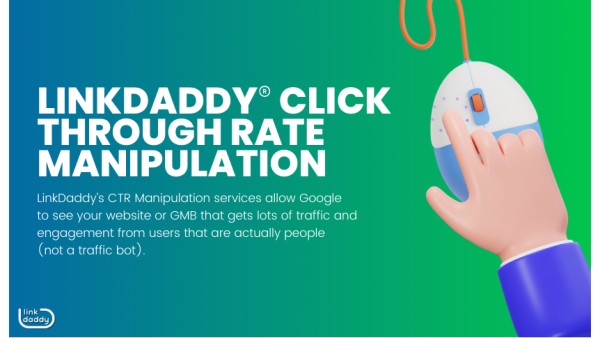Take Advantage Of CTR Manipulation to Boost Click-Through Fees
The manipulation of click-through rates (CTR) has arised as a crucial method for improving on the internet engagement and driving web traffic. The great line in between efficient control and moral boundaries increases crucial questions about the long-lasting ramifications of such methods.

Recognizing Click-Through Fees
Click-through prices (CTR) serve as a critical metric in electronic marketing, reflecting the performance of on-line material in engaging target markets. CTR is determined by splitting the number of clicks an advertisement or link gets by the variety of times it is presented (perceptions), shared as a percentage. A greater CTR shows that the web content resonates well with the target market, motivating them to take action, while a reduced CTR might suggest a detach in between the content and its intended visitors.
Comprehending CTR is essential for maximizing marketing approaches. CTR Manipulation. Numerous elements affect CTR, consisting of the quality of the web content, the significance of the keyword phrases, the layout of the ad, and the total individual experience. Analyzing CTR can supply insights right into audience preferences and behavior, allowing online marketers to make data-driven decisions
Furthermore, CTR is crucial for assessing the performance of different marketing networks, such as e-mail projects, social networks ads, and internet search engine advertising. By continually keeping track of and analyzing CTR, marketing experts can improve their tactics, ultimately resulting in improved involvement and boosted roi (ROI) Thus, a comprehensive understanding of CTR is crucial for any effective electronic advertising strategy.
Crucial Element to Control
Several essential aspects can be tactically manipulated to improve click-through rates and maximize involvement. The first component is the heading, which should be engaging and clear, ideally sharing the worth suggestion succinctly. A well-crafted headline can record attention and lure customers to explore additionally.
Next, making use of visuals plays a vital duty. Appealing images, graphics, or video clips can substantially raise involvement by damaging text uniformity and providing an aesthetic cue that draws the eye. In addition, the positioning of elements on the web page must be considered; calculated positioning can direct users to concentrate on calls-to-action (CTAs)
Another essential element is the meta description. A succinct and appealing meta summary can serve as an intro that encourages users to click via by summing up the content properly. Likewise, using necessity in language-- such as limited-time deals-- can produce a feeling of immediacy, prompting individuals to act rapidly.
Finally, maximizing for mobile gadgets is vital, as a significant portion of individuals gain access to web content through smart devices. Making certain that all components are mobile-friendly can significantly enhance the likelihood of clicks, thus improving general CTR.
Methods for Effective CTR Boosting
Applying reliable techniques for improving click-through prices calls for a tactical technique that incorporates creative thinking and data-driven understandings. One vital approach is optimizing headlines and meta summaries, ensuring they are compelling and pertinent to the target audience. Crafting headings that stimulate interest or urgency can considerably improve individual involvement.
One more method includes A/B screening various components of your web content, such as pictures, layouts, and call-to-action buttons. This screening allows you to determine which combinations reverberate best with your target market, resulting in improved performance.
Utilizing appealing visuals can additionally play a critical role in CTR enhancement. High-quality photos, infographics, and videos can draw attention and encourage clicks. Furthermore, executing organized data can improve the look of your listings in search results page, making them a lot more enticing.
Customization is another effective approach; customizing web content to specific customer choices can improve relevance and drive involvement. Leveraging social evidence, such as reviews and endorsements, can establish count on and encourage clicks. By employing these techniques, marketing professionals can strategically improve their click-through prices and drive more web traffic to their content.
Ethical Factors To Consider in CTR Adjustment
The adjustment of click-through prices (CTR) raises considerable moral considerations that marketing experts must navigate meticulously. As organizations make every effort for greater CTRs to enhance visibility and drive conversions, the line in between appropriate optimization methods and misleading practices can blur - CTR Manipulation. Ethical marketing necessitates transparency and honesty, ensuring that consumers are not misdirected by exaggerated cases or misleading marketing strategies
Furthermore, utilizing methods that alter CTR metrics, such as clickbait headings or misleading material, can deteriorate customer trust in time. This not only harms brand reputation yet can likewise result in regulatory examination, especially in an age where consumer security laws are GMB CTR Manipulation becoming increasingly stringent.

Measuring Success and Changing Methods
Recognizing the ethical implications of CTR manipulation establishes the phase for effectively gauging success and readjusting methods. The initial action in assessing the efficiency of your CTR adjustment initiatives is to develop clear, measurable metrics.

Additionally, be prepared to pivot your approaches based on the comments and data gathered. If specific strategies result in high CTR but reduced engagement, it might show a misalignment in between assumptions and content high quality. Regular improvement, driven by data evaluation, will certainly help guarantee that your CTR control initiatives are not only effective but also sustainable and aligned with moral advertising techniques.
Verdict
Finally, leveraging CTR control via strategic optimization of content components can significantly enhance audience interaction and increase click-through prices. Employing techniques such as compelling headings, distinctive visuals, and targeted calls-to-action, alongside moral considerations, ensures openness and fosters count on. Normal dimension of success and change of techniques based upon data-driven insights will help with continuous improvement. Inevitably, a well balanced method to CTR manipulation will produce lasting results while maintaining customer partnerships.